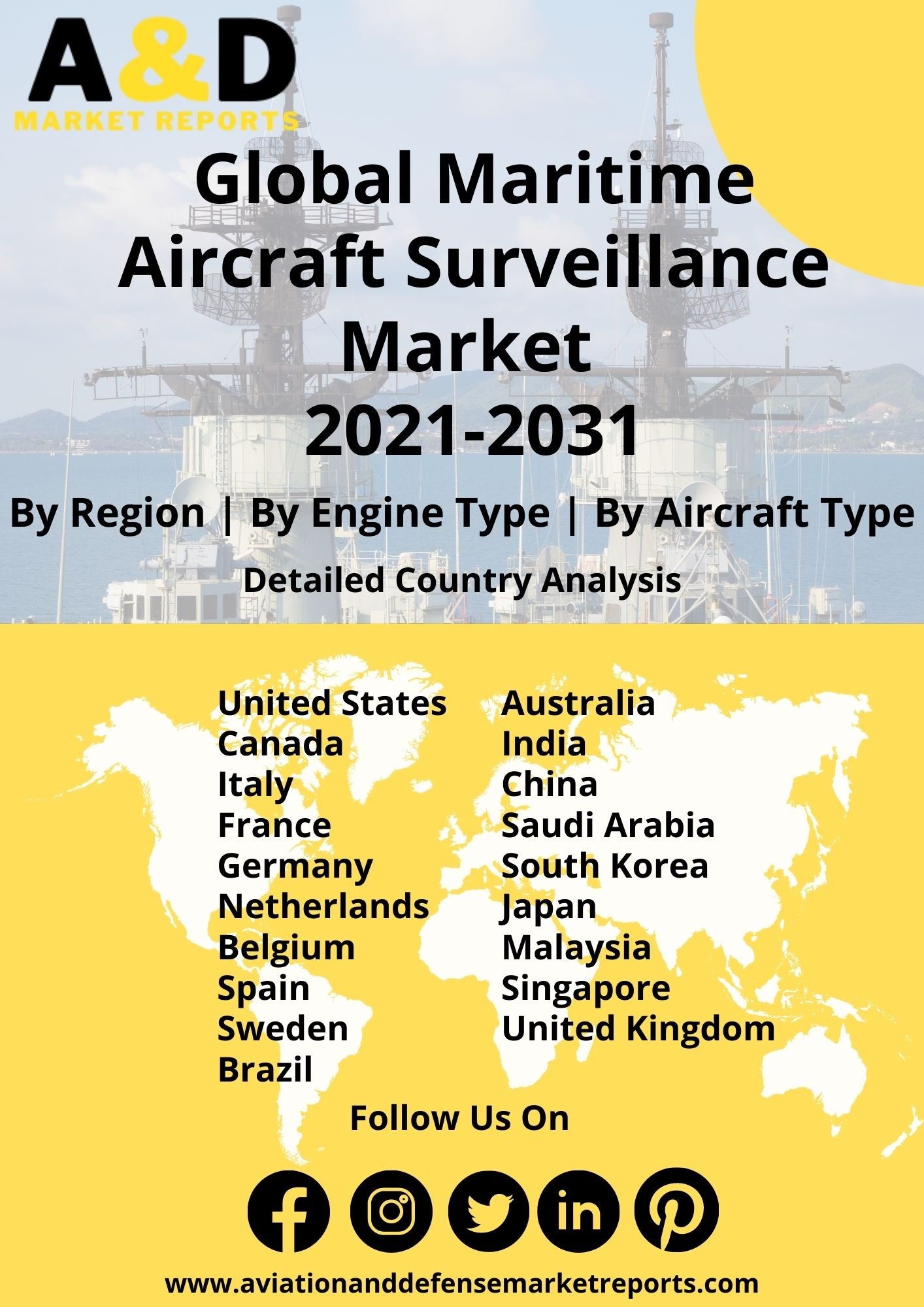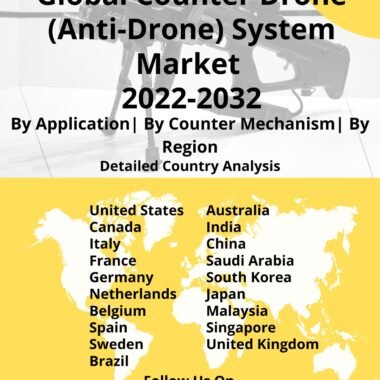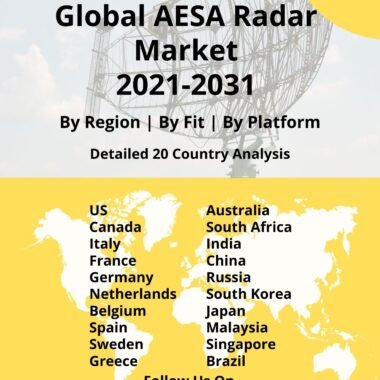Description
Maritime Aircraft Surveillance Market
Frequently Asked Questions of MAS Market
A maritime patrol aircraft is a jet-powered aircraft designed to fly over sea and ocean areas for the purpose of patrolling them with the use of tactical surveillance equipment, electronic intelligence gathering systems and weapon systems. Modern patrol aircraft like P-8A Poseidon is an asset to any naval force. Naval-technology.com lists the top ten maritime patrol aircraft based on range, endurance and patrolling capabilities.
Maritime aircraft surveillance market are responsible for conducting maritime patrol, anti-submarine, as well as anti-surface warfare. Maritime surveillance aircrafts market size are capable of performing ISR missions and carrying out patrol missions. Since they are designed to be easy to operate, these aircrafts are equipped with latest technology and equipment so that they can perform multiple tasks effectively. An alternative to sonar, the Advanced Airborne Sensor (AAS) will allow P-8 Poseidon aircraft to detect submarines from above and below the surface of the water, providing vital information for anti-submarine operations. The AN/APS-154 Advanced Airborne Sensor (AAS) will spot the invisible wakes left by submarines underwater, telltale clues that something large is lurking beneath the waves.
The downward-mounted pod features an advanced AESA radar that detects threats with a wider field of detection and greater range than traditional dish radars. Unlike traditional dish radars that use one large, powerful radar module, these AESA radars use many smaller modules that operate over multiple frequencies and can overcome jamming or broaden or focus their field of detection, especially against small objects and those invisible to the human eye.
Major factors driving Maritime Aircraft Surveillance Market Growth
As underwater platforms and weapons improve, anti-submarine doctrine must be revised. A smaller fleet of SSBNs, SSNs, and SSGNs operate in shallower littoral waters than with the entire fleet submerged at one time in the past. They also deploy their own UUVs that complicate the anti-submarine picture. Other short-range platforms include midget submarines, swimmer deliver vehicles and semi-submersibles that threaten surface ships forced to operate or transit closer to the shore or through choke points. There is need to develop new ways to detect submarines that could be deployed by manned or unmanned platforms including long-range acoustic surveillance with active sonar.
Trends influencing the Maritime-Aircraft Surveillance Market Size
Maritime surveillance aircraft market analysis, There is increasing need for unmanned aerial platforms for maritime surveillance. The goal of the anti-submarine drone is to achieve greater detection range and to discriminate decoys against torpedoes, UUVs, small submersibles and rockets. Maritime surveillance aircraft market trends, a significant reduction in weight would also be helpful allowing it to be delivered by small UAVs, although it is likely to retain the same dimensions and form factor as Sting Ray for backwards compatibility with existing launch systems. The ability to accept wing-kits would allow extended-range launch from altitude. New more power-dense batteries could also increase speed or range and active sonar capability.
Maritime surveillance aircraft market trends, the exiting platforms are upgraded to meet the requirements of advanced information and communication technology advances, and the need to collect, manage, process and deliver information in rapid time-or-space fashion. The system features 360° rotating multi-mode maritime surveillance radar, electro-optical sensors with laser payloads for day/night surveillance support and for target identification, automatic identification system (AIS), identification friend or foe (IFF), electronic warfare and self-protection system. The system also provides SATCOM links to other platforms as well as tactical data links which can be linked by a secure data link to any headquarters’ command center.
Maritime-Aircraft Surveillance Market Forecast & Dynamics
Maritime surveillance aircraft market forecast, Increasing defense spending will drive themaritime surveillance aircraft market size for new procurement activities and upgrades to existing platforms with newer technologies and capabilities. The increase in defense spending will encourage procurement of aircrafts and related systems to step up their production volumes and improve their quality, thereby enhancing competition in the global markets. Procurement will also be driven by prevailing geo political conditions in Europe and the Asia Pacific. Proliferation of underwater naval platforms in these regions will be one of the key drivers of the maritime surveillance aircraft market size..
Maritime Aircraft Surveillance Market Analysis for Recent Developments
Maritime surveillance aircraft market reports, the T-150 UAV has a wingspan of 2.5 m, a length of 4.8 m and a weight of 110 kg. The T-150 UAV is capable of carrying more than 400 lbs (180 kg) of payload for surveillance purposes, including cameras and sensors such as radar; this is nearly twice the size of Merlin’s internal payload bay and making it more suitable for carrying heavier loads would add another important capability than just conducting ASW attacks from 30 km away.
Maritime surveillance aircraft market reports, Proteus is an evolved medium-sized UAS designed to provide higher levels of autonomous operation and comprehensive mission flexibility. The FMC is seeking proposals from industry for a mid-sized Rotary Wing UAS capable of hunting submarines via sonobuoy and dipping sonar to supplement Merlin Mk2. Proteus will need to be a sizeable aircraft as is also intended to provide surface search functions and contribute Maritime Intra-Theatre Lift (MITL).
The market is a critical component in the maritime domain’s efforts to ensure comprehensive maritime security and effective maritime domain awareness. Maritime surveillance aircraft play a pivotal role in monitoring and patrolling vast oceanic expanses, providing real-time information on maritime activities, potential threats, and ensuring the safety of sea lanes. The market is witnessing significant growth due to the increasing recognition of the importance of maritime surveillance in safeguarding national interests, combating piracy, preventing illegal activities, and responding to maritime emergencies.
Technological innovations within the Maritime Aircraft Surveillance market include advanced radar systems, electro-optical sensors, and satellite communication capabilities, enhancing the aircraft’s ability to detect, track, and communicate with surface vessels. These innovations contribute to improved situational awareness, response times, and the overall effectiveness of maritime security operations. Geopolitical considerations, coupled with the growing importance of maritime trade and resource exploration, drive investments in Maritime Aircraft Surveillance capabilities globally. In 2023, the global market signifies a commitment to leveraging cutting-edge technology for enhanced maritime security, reinforcing the critical role of surveillance aircraft in addressing the evolving challenges in the maritime domain.”







